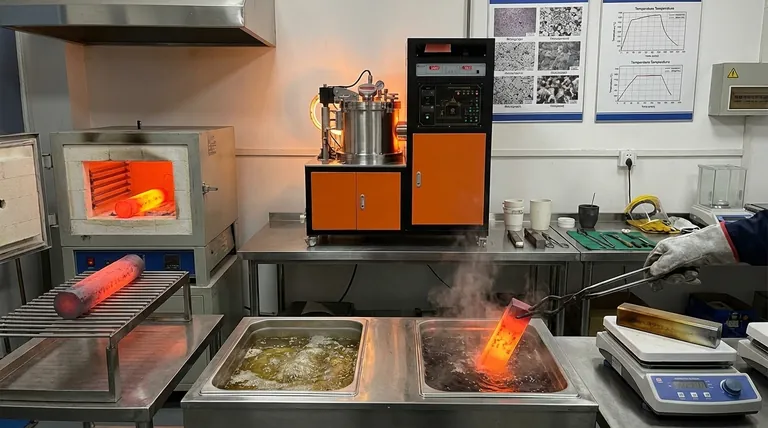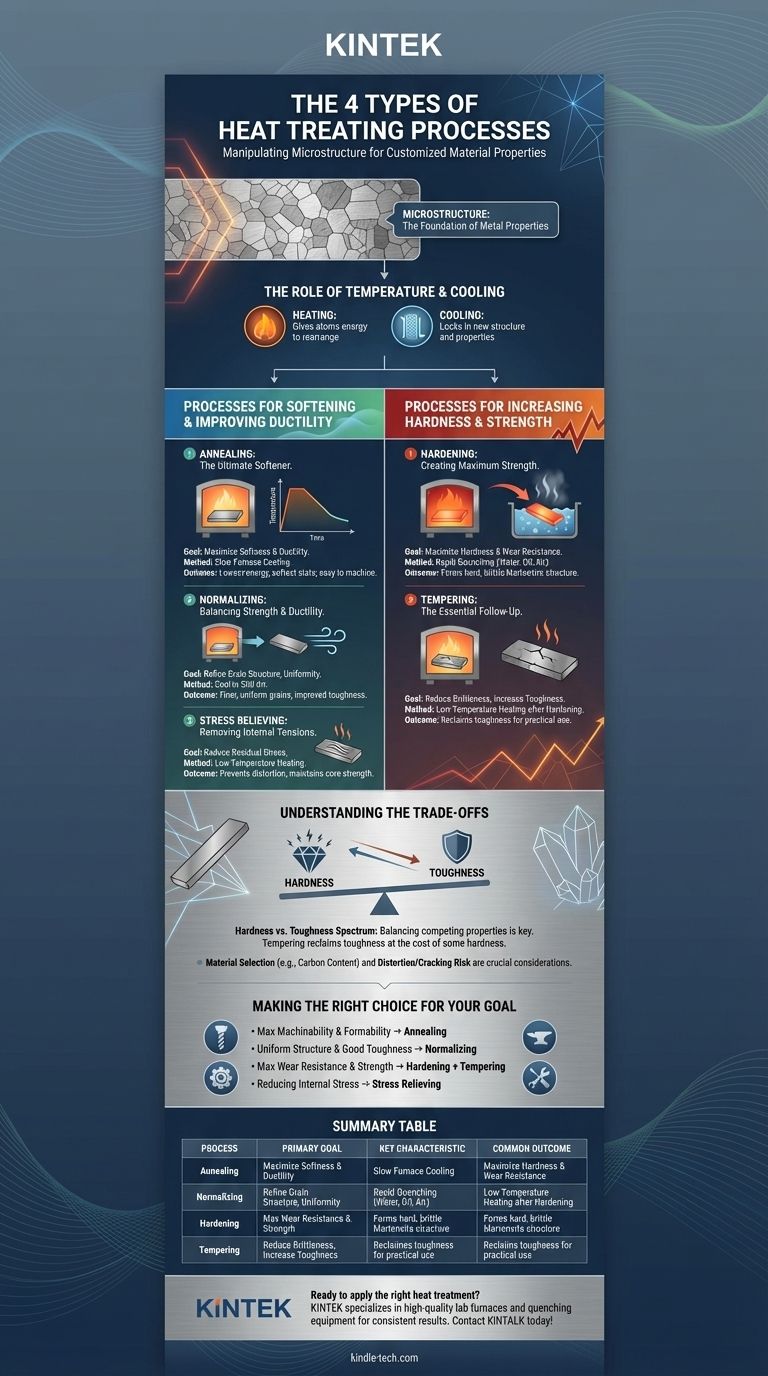The four primary types of heat treatment are annealing, normalizing, hardening, and tempering. These controlled processes of heating and cooling are used to deliberately manipulate a metal's internal structure, fundamentally changing its mechanical properties like strength, hardness, and ductility to fit a specific engineering need.
Heat treatment is a toolkit for controlling the trade-off between a metal's strength and its toughness. The specific process you choose is determined by whether the goal is to make a material softer and more workable or harder and more wear-resistant.

The Goal: Manipulating Microstructure
Heat treatment works by altering the microscopic crystalline structure within a metal. Understanding this basic principle is key to understanding why each process yields a different result.
What is a Microstructure?
Most metals are made of tiny, tightly packed crystals called grains. The size, shape, and composition of these grains—the metal's microstructure—directly dictate its mechanical properties.
The Role of Temperature and Cooling
Heating a metal gives its atoms energy, allowing them to move and rearrange the crystalline structure. The rate at which the metal is cooled then locks in a specific new structure, and therefore, a new set of properties.
Processes for Softening and Improving Ductility
These processes generally involve slower cooling rates to produce a softer, more uniform material that is easier to machine or form.
Annealing: The Ultimate Softener
Annealing is a process used to make a metal as soft and ductile (formable) as possible. It also relieves internal stresses and refines the grain structure.
The process involves heating the metal, holding it at that temperature for a set time, and then cooling it very slowly, often by leaving it inside the turned-off furnace. This slow cool allows the microstructure to form in its lowest-energy, softest state.
Normalizing: Balancing Strength and Ductility
Normalizing also refines the grain structure but results in a material that is slightly harder and stronger than an annealed one.
The key difference is the cooling method. After heating, the metal is removed from the furnace and cooled in still air. This faster cooling rate produces a finer, more uniform grain structure, improving toughness and machinability over an as-cast or annealed state.
Stress Relieving: Removing Internal Tensions
Stress relieving is a low-temperature annealing process used to reduce internal stresses created during manufacturing processes like welding, machining, or cold working. This is done without significantly changing the metal's core mechanical properties, helping to prevent distortion over time.
Processes for Increasing Hardness and Strength
These processes are defined by very rapid cooling to lock in a hard, brittle microstructure, which is then modified to add toughness.
Hardening: Creating Maximum Strength
Hardening is used to significantly increase the hardness and wear resistance of a metal, particularly steel.
The process involves heating the metal to a critical temperature where its crystal structure changes, followed by quenching—an extremely rapid cooling in a medium like water, oil, or air. This rapid cooling traps the crystal structure in a very hard but brittle state known as martensite.
The Critical Role of Quenching
It is crucial to understand that quenching is a step within the hardening process, not a standalone type of heat treatment. The choice of quenching medium (water being the fastest, oil medium, air the slowest) is critical for controlling the final hardness and minimizing the risk of cracking.
Tempering: The Essential Follow-Up
A metal that has been hardened is often too brittle for practical use. Tempering is a secondary, low-temperature heat treatment that is performed after hardening.
It reduces some of the extreme hardness and brittleness, while significantly increasing the material's toughness (its ability to absorb impact without fracturing).
Understanding the Trade-offs
Choosing a heat treatment process is always an exercise in balancing competing properties.
The Hardness vs. Toughness Spectrum
The most fundamental trade-off is between hardness and toughness. As you increase a metal's hardness through hardening, you almost always decrease its toughness, making it more brittle. Tempering is the process used to reclaim some of that toughness at the expense of a little hardness.
Material Selection is Crucial
Not all metals can be effectively hardened. The ability of steel to be hardened, for instance, is directly dependent on its carbon content. Low-carbon steels cannot be significantly hardened through this process, while high-carbon and alloy steels can.
The Risk of Distortion and Cracking
The rapid temperature changes involved in hardening and quenching create immense internal stress. This can cause parts to warp, distort, or even crack if the process is not carefully controlled.
Making the Right Choice for Your Goal
Your final objective dictates the correct process. By understanding the outcome of each method, you can precisely engineer a material's properties.
- If your primary focus is maximum machinability and formability: Use full annealing to achieve the softest and most ductile state possible.
- If your primary focus is creating a uniform internal structure with good toughness: Normalizing is the correct choice, especially for components like forgings or castings.
- If your primary focus is achieving maximum wear resistance and strength: A combination of hardening followed immediately by tempering is the necessary two-step process.
- If your primary focus is reducing internal stress from manufacturing: Use a low-temperature stress relief process to ensure dimensional stability without altering core strength.
Ultimately, mastering heat treatment allows you to transform a standard metal into a high-performance material tailored for its specific task.
Summary Table:
| Process | Primary Goal | Key Characteristic | Common Outcome |
|---|---|---|---|
| Annealing | Soften & Increase Ductility | Slow furnace cooling | Maximizes machinability and formability |
| Normalizing | Refine Grain Structure | Cooling in still air | Improves toughness and uniformity |
| Hardening | Increase Hardness & Strength | Rapid quenching | Creates a hard, wear-resistant surface |
| Tempering | Reduce Brittleness | Low-temperature heating after hardening | Increases toughness for practical use |
Ready to apply the right heat treatment to your materials?
The precise control of temperature and cooling rates is critical for successful heat treatment. KINTEK specializes in providing the high-quality lab furnaces, ovens, and quenching equipment you need to achieve consistent, reliable results for annealing, normalizing, hardening, and tempering processes.
Let our experts help you select the perfect equipment for your laboratory's specific needs.
➡️ Contact KINTALK today to discuss your application
Visual Guide

Related Products
- Vacuum Heat Treat Furnace and Levitation Induction Melting Furnace
- Vacuum Heat Treat Furnace with Ceramic Fiber Liner
- Molybdenum Vacuum Heat Treat Furnace
- 2200 ℃ Tungsten Vacuum Heat Treat and Sintering Furnace
- Vacuum Heat Treat Sintering Brazing Furnace
People Also Ask
- What is the difference between annealing hardening and tempering? Master Metal Properties for Your Lab
- What are the three main heat treatments? Mastering Annealing, Hardening & Tempering
- What is low temperature vacuum? A Guide to Precision, Oxide-Free Thermal Processing
- What is the process of vacuum quenching? Achieve Superior Hardness with a Pristine Surface Finish
- What are the different types of heat treatment process for steel? Tailor Strength, Hardness & Toughness



















